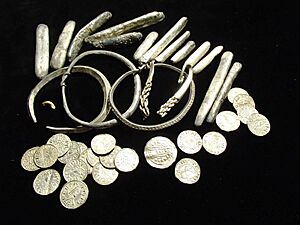Watlington Hoard facts for kids
Quick facts for kids Watlington Hoard |
|
|---|---|
 |
|
| Material | Silver, Gold |
| Created | 9th century |
| Period/culture | Viking |
| Discovered | Watlington, Oxfordshire, by James Mather, 2015 |
| Present location | British Museum |
The Watlington Hoard is a special collection of Viking silver. It was buried a very long time ago, in the 870s. This amazing treasure was found again in 2015 in a place called Watlington, which is in Oxfordshire, England.
Contents
What is the Watlington Hoard?
This treasure, or hoard, is mostly made of silver. It includes 186 coins, some of which are broken. There are also 15 silver bars called ingots. Plus, there are 7 pieces of beautiful jewellery, like arm-rings. A tiny piece of gold was also found.
How Was It Found?
The hoard was buried after a big battle in 878. In this battle, a famous king named Alfred the Great defeated the Great Heathen Army. This army was led by a Viking leader named Guthrum. After their defeat, the Danes (Vikings) had to move north.
An amateur metal-detectorist named James Mather found the hoard in 2015. A metal-detectorist uses a special machine to find metal objects hidden underground. After he found it, experts carefully dug it up.
Why is This Hoard Important?
The time when this hoard was buried was a period of many wars. These wars were between the Danish (Viking) kingdoms and the Anglo-Saxon kingdoms in England. Historians, who study the past, are very interested in this time.
The coins in the hoard are very special. They were made by King Alfred the Great and another king named Ceolwulf II. These coins can help us learn new things about how the kingdoms of Mercia and Wessex worked together in the 800s.
Some of the coins even show both kings sitting side by side. This style is called "Two Emperors." It was copied from old Roman coins. These coins were made to show that the two kings were working together and were powerful.
Where Can You See It Now?
In February 2017, it was announced that the Ashmolean Museum in Oxford bought the hoard. They paid £1.35 million for it! This was done to keep the treasure in the county where it was found. Money for the purchase came from the National Lottery, the Art Fund, and donations from local people.

